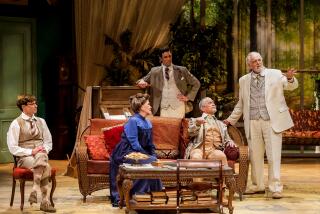OBITUARIES : B. Fletcher; Personifier of G.B. Shaw
- Share via
Bramwell Fletcher, a seasoned stage and screen actor who--adorned in tweedy knickers and Shavian beard--brought George Bernard Shaw from the printed page to performance halls around the world, died Wednesday at a nursing home in Westmoreland, N.H.
The New York Times in its Friday editions said he was 84 and had been living in Keene, N.H.
A cohort of John Barrymore, who numbered Barrymore’s daughter, Diana, among his four wives, Fletcher made his first stage appearance in 1927 at the Shakespeare Memorial Theatre in Stratford-Upon-Avon in his native England. After performing in London for two years in a variety of roles, he went to Broadway as Kent Heathcote in “Scotland Yard.” He had sailed on the same ship with Laurence Olivier, who became a lifelong friend.
Thereafter, Fletcher continued to live in the United States. He came to Hollywood and was seen in such pictures as “Raffles,” “Svengali,” “A Bill of Divorcement” and “The Mummy.” But he was refused permission by producer Samuel Goldwyn to appear in a film with Greta Garbo and left Hollywood to return to New York.
Lifelong Preoccupation
There he began a lifelong preoccupation with Shavian drama while also appearing in the plays of Shakespeare, Ibsen, Chekhov and others. His co-stars over the years included Helen Hayes, Katharine Cornell, Laurette Taylor and Cornelia Otis Skinner.
One of his longest periods of employment was as understudy to Rex Harrison as Prof. Henry Higgins in “My Fair Lady.”
In the 1950s and early 1960s, he created his one-man show, “The Bernard Shaw Story,” in which he used anecdotes and comments to re-create the venerated Irish playwright for new generations. He opened his costumed monologue in Dublin and then toured small concert halls and college campuses in the United States. Locally, he was seen at Occidental College in February, 1967, where The Times critic praised his performance as “a lively portrait of the playwright as artist and man.”
He also had returned to films in the 1940s and was seen in “Random Harvest,” “White Cargo,” “The Immortal Sergeant” and others.
Most recently, he collaborated with Lael Wertenbaker in an educational project for the National Endowment for the Humanities. She became his last wife.
More to Read
The biggest entertainment stories
Get our big stories about Hollywood, film, television, music, arts, culture and more right in your inbox as soon as they publish.
You may occasionally receive promotional content from the Los Angeles Times.










